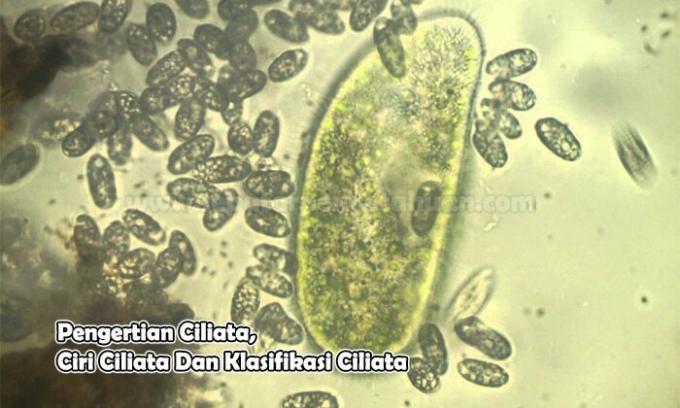Definition of Ciliates, Characteristics & Classification (Complete)
Definition of Ciliates, Characteristics & Classification (Complete) – still discussing about biology, this time we will discuss about ciliates. Surely many do not know about ciliates and ask what are ciliates?
Therefore, here we will discuss about ciliates and can help knowledge seekers and those who want to understand about biology, including ciliates. For that you must read and listen to the reviews of this article. To be able to easily understand, let's start a discussion about ciliates.
list of contents
-
Definition of Ciliates, Characteristics & Classification (Complete)
- Definition of Ciliates
- Characteristics of Ciliates
-
Classification Of Ciliates
- 1. Paramecium
- 2. Vorticella
- 3. Didinium
- 4. Stentor
- 5. Balantidium coli
- The Role Of Ciliates
- Share this:
- Related posts:
Definition of Ciliates, Characteristics & Classification (Complete)
Let's discuss the meaning of ciliates first carefully.
Definition of Ciliates
Ciliates are single-celled protists and their body surface is covered with vibrating hairs. Ciliates are derived from the word cillium which means vibrating hair, while ciliophora can move using cilia or vibrating hairs. So that ciliates and also ciliophora are animals that can move using hair tools vibrates or cilia, and at a stage of its life and is used as a means of locomotion and also to search for food.
The size of the cilia itself is shorter than the flagellum, and has two nuclei (nucleus). Namely the macronucleus or large nucleus that controls the function of daily living RNA, and is important for asexual reproduction. And the micronucleus or these tiny ones that are exchanged during conjugation for the process of sexual reproduction. And also found contractile vacuole which has a function to maintain water balance in the body.
Characteristics of Ciliates
Ciliates also have characteristics and also some characteristics that can distinguish other types of protozoa. In order to more clearly know what are the characteristics of ciliates, let's see below.
- Have heterotrophs
- Moves using cilia (vibrating hair)
- In general, they have a microscopic size, but there are also species that have a size of 3 mm so that they can be seen with the naked eye
- Binary fission
- Helps the movement of food towards the cystoma
- Found in all parts of the cell and also in certain parts
- Has an oval body shape and also does not change or stay
- Live freely in a watery environment, either in sea water or fresh water which contains a lot of organic substances
- Live in a parasitic, symbiotic way and some live in the wild
- Has two cell nuclei, a macronucleus and a micronucleus
Classification Of Ciliates
The following is a classification of ciliates.
1. Paramecium
A type of ciliates that is blunt at the front and tapered at the back so that it looks like a shoe or sandal
2. Vorticella
Types of ciliates that have a bell-like shape and are also long-stemmed with a straight or spiral shape that has cilia around the mouth. Its life is in fresh water, attached to the stems that are contractile and also substrate. The food is bacteria or the remnants of organic matter that enter simultaneously through the gaps of his mouth.
3. Didinium
This type of ciliates are predators in aquatic ecosystems, which are predators of pramecium
4. Stentor
This type of ciliates has a trumpet-like shape and also settles in stagnant or flowing fresh water, the food of these animals is ciliates which have a smaller size.
5. Balantidium coli
This type of ciliates is the largest in the large intestine and is the only group of human ciliates that are pathogenic and also cause balantidiasis or ciliate dysentery. This type of ciliates can be found in tropical or sub-tropical areas.
The Role Of Ciliates
Ciliates also have a role that can be beneficial and also detrimental. What are the roles of ciliates, let's discuss in the next section.
- The Beneficial Role of Ciliates such as Didinium which is similar to a stemmed kettle which has a role as a predator in fresh water
- The harmful role of ciliates such as Balantidium coli which lives as a parasite in the human intestine which can cause stomach upset and can also cause bloody diarrhea.
That's the explanation that has been given about Definition of Ciliates, Characteristics & Classification (Complete), ciliata a protist whose body is overgrown with vibrating hairs that have a function for movement, may be useful.
Read also:
- Understanding Bacteria, Types, Characteristics and Roles for Human Life
- Definition of Price Index, Uses, Characteristics, Types, Role of Price Index
- Hair Functions, Disorders and Diseases (Full Discussion)
- Definition of Family, Characteristics, Functions, Kinds, Tasks, Family Roles
- Understanding Hair and Hair Structure (Full Discussion)

